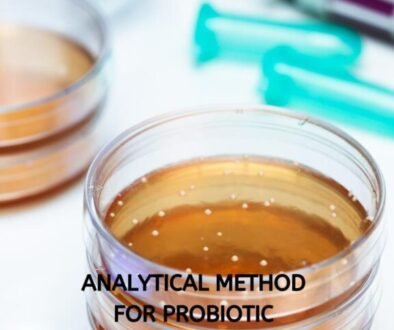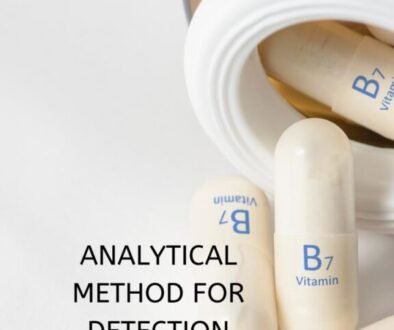TO ORDER B-Complex CONTACT VIA WHATSAPP – +91-8090113353 OR VIA EMAIL – info@rass-biosolution.com

B-complex vitamins are essential nutrients that play a crucial role in maintaining overall health and well-being. They are involved in many vital processes within the body, including energy production, metabolism, and the functioning of the nervous system. Ensuring that these vitamins are present in the right amounts in supplements, food products, and animal feed is essential. This is where analytical methods for B-complex detection come into play.
In this blog, we will explore some of the most common analytical techniques used to detect B-complex vitamins, making it easier for manufacturers and consumers to ensure the accuracy and quality of B-complex formulations.
What is B-Complex?
B-complex refers to a group of eight essential vitamins that include:
- Vitamin B1 (Thiamine)
- Vitamin B2 (Riboflavin)
- Vitamin B3 (Niacin)
- Vitamin B5 (Pantothenic acid)
- Vitamin B6 (Pyridoxine)
- Vitamin B7 (Biotin)
- Vitamin B9 (Folic acid)
- Vitamin B12 (Cobalamin)
These vitamins work together to promote proper cell function and support various bodily functions, such as energy production, red blood cell formation, and the synthesis of DNA. Because they are water-soluble, they cannot be stored in the body, meaning regular intake is essential.
Why is B-Complex Detection Important?
Ensuring the correct amount of B-complex vitamins is crucial for both human and animal health. Accurate detection and measurement of B-complex vitamins in supplements, food products, and animal feed help in:
- Maintaining Nutritional Balance: Correctly measuring B-complex vitamins ensures that individuals or animals receive the proper nutritional amounts they need.
- Quality Control: Accurate testing ensures the consistency and quality of products, preventing under- or overdosing of these essential nutrients.
- Regulatory Compliance: Many countries have strict guidelines on the allowable levels of B-complex vitamins in food and supplements. Analytical testing helps ensure products meet these regulatory standards.
Common Analytical Methods for B-Complex Detection
There are several analytical techniques available to detect and quantify B-complex vitamins. Let’s look at some of the most commonly used methods:
1. High-Performance Liquid Chromatography (HPLC)
HPLC is a widely used method for analyzing B-complex vitamins, particularly when dealing with complex mixtures. It separates the components of a sample based on their chemical properties, allowing for accurate quantification of each vitamin.
Why use HPLC?
- High precision: HPLC is known for its accuracy and reliability in detecting low levels of B vitamins.
- Versatility: It can separate multiple B vitamins in one analysis, making it ideal for testing B-complex formulations.
- Suitable for both food and supplement analysis.
2. Spectrophotometry
Spectrophotometry is a simpler, more cost-effective method that measures how much light a sample absorbs at specific wavelengths. Each B-vitamin absorbs light differently, which allows for their identification and quantification.
Why use Spectrophotometry?
- Quick and inexpensive: This method is ideal for routine testing when you need fast results.
- Good for water-soluble B-vitamins: It is particularly effective for analyzing B-complex vitamins like B2 (Riboflavin) and B3 (Niacin).
3. Liquid Chromatography-Mass Spectrometry (LC-MS)
LC-MS combines the separation abilities of liquid chromatography with the highly sensitive detection power of mass spectrometry. This method is excellent for detecting trace amounts of B-complex vitamins in complex samples.
Why use LC-MS?
- Highly sensitive and accurate: LC-MS can detect even small amounts of B vitamins in complicated formulations.
- Simultaneous detection: It allows for the simultaneous analysis of multiple B-vitamins, which is ideal for B-complex testing.
4. Enzyme-Linked Immunosorbent Assay (ELISA)
ELISA is an immunoassay that uses antibodies to detect specific B-vitamins or their metabolites in a sample. It’s highly specific and can be used for rapid on-site testing.
Why use ELISA?
- High specificity: ELISA can be used to detect a particular B-vitamin with great accuracy.
- Quick and easy: It provides fast results and is easy to perform, making it suitable for field testing.
5. Titrimetric Methods
Titrimetric methods use a chemical reagent to react with the vitamin in question, allowing for its quantification. For example, Vitamin B1 (Thiamine) can be tested using iodine-based titration.
Why use Titrimetric Methods?
- Simple and inexpensive: These methods are basic and budget-friendly.
- Good for specific B-vitamins: Ideal for detecting certain B-vitamins like Thiamine.
Best Practices for B-Complex Vitamin Detection
To ensure the most accurate and reliable results when testing B-complex vitamins, manufacturers and labs should follow a few best practices:
1. Regular Testing
Regularly testing B-complex vitamin levels in your products ensures consistency and allows for immediate correction if discrepancies arise.
2. Choose the Right Method
Choose the most appropriate analytical method based on the specific needs of your product and the B-vitamin in question. For more complex samples, HPLC or LC-MS may be ideal, while simpler methods like spectrophotometry or ELISA may be sufficient for routine testing.
3. Calibration and Validation
Always calibrate your equipment and validate your methods to ensure accuracy. Reliable equipment and properly calibrated systems are essential for achieving trustworthy results.
4. Compliance with Regulations
Make sure that your products comply with local regulatory standards for B-complex vitamin levels. Regulatory agencies often have specific permissible ranges, and analytical testing ensures your products meet these guidelines.
5. Training and Expertise
Ensure that laboratory personnel are trained and experienced in performing vitamin testing. Expert technicians are essential for using complex equipment and interpreting results accurately.
Challenges in B-Complex Detection
While detecting B-complex vitamins is crucial, the process does come with its challenges. Some of the primary obstacles include:
1. Complex Formulations
B-complex vitamins often come in formulations that contain many other nutrients, minerals, and ingredients. This can make it difficult to isolate and accurately measure the vitamin content. Advanced methods like HPLC and LC-MS are required to separate the B-vitamins from other substances in the sample.
2. Vitamin Instability
Some B-vitamins are sensitive to heat, light, and oxygen, which can cause degradation over time. For example, vitamin B1 (Thiamine) is highly susceptible to heat, while vitamin B12 (Cobalamin) can be easily broken down by light. As a result, manufacturers must ensure that their products are stored and tested under controlled conditions to preserve the integrity of the vitamins.
3. Low Concentrations
In many cases, the levels of B-complex vitamins in a sample may be very low, which makes their detection a challenge. For instance, vitamin B12 is often present in trace amounts, requiring sensitive detection methods such as LC-MS to ensure accurate measurement.
4. Matrix Interference
Matrix interference occurs when other components in the sample affect the measurement of vitamins, leading to inaccurate results. For example, minerals in the sample might interfere with the analysis of B-vitamins, which is why careful sample preparation is critical when testing complex formulations.
Future Trends in B-Complex Detection
The field of B-complex vitamin detection is evolving rapidly. Here are some trends and innovations that are shaping the future of vitamin testing:
1. Automation in Testing
Automation is playing a key role in improving the speed and efficiency of vitamin detection. With automated systems, manufacturers can process multiple samples simultaneously, reducing human error and increasing throughput. These systems also allow for continuous monitoring, ensuring that vitamin levels stay consistent throughout production.
2. Portable Testing Devices
Portable testing devices for B-complex vitamins are becoming more common. These devices use advanced sensors to provide quick, on-site results without the need for complex laboratory setups. Portable testers are particularly beneficial for field testing in agriculture and animal husbandry, where rapid results are required to make real-time decisions.
3. Advanced Nanotechnology
The integration of nanotechnology in vitamin detection is gaining momentum. Nanomaterials can enhance the sensitivity of detection methods, enabling the identification of trace levels of B-complex vitamins in a sample. These advancements may open up new possibilities for more precise and faster testing methods.
4. Sustainable and Green Chemistry Approaches
As industries shift toward more sustainable practices, there is growing interest in green chemistry. This includes developing analytical methods that use fewer chemicals, reduce waste, and require less energy. Green chemistry methods will not only make testing more eco-friendly but also more cost-effective for manufacturers.
Conclusion
B-complex vitamins are essential for maintaining good health, and detecting the right levels in food, supplements, and animal feed is crucial for ensuring proper nutrition and regulatory compliance. Methods like HPLC, spectrophotometry, LC-MS, ELISA, and titrimetric testing offer reliable ways to measure and quantify these vital nutrients.
At Rass Bio Solution, we are committed to providing advanced testing services for B-complex vitamins, ensuring your products meet the highest quality and safety standards. Whether you’re manufacturing nutritional supplements, food products, or animal feed, we offer precise and reliable analytical services to support your business. Contact us today.
COMPARATIVE ANALYTICAL METHODS FOR B-COMPLEX DETECTION
METHOD | ADVANTAGES | LIMITATIONS | SUITABILITY FOR B-COMPLEX ANALYSIS |
Electrochemical Methods | Potentially simpler and faster – Portable | -Low Specificity (difficulty differentiating B vitamins) – Lower Sensitivity Challenges with complex samples | Not currently suitable for routine B-complex analysis (under development) |
Spectrophotometry | Quick and inexpensive Initial screening | -Low Specificity (overlapping absorbance peaks) -Limited quantitative ability – Interference from other components | Limited use, might suggest B-complex presence but is not definitive for individual vitamins |
Derivative UV Spectrophotometry | Improved Specificity (partially addresses overlapping peaks) – Reduced background noise (compared to UV) | -Limited improvement (may not differentiate all B vitamins) – Quantitative challenges – Sample matrix dependence | Potentially useful for enhanced qualitative analysis, but limitations remain |
Spectrofluorimetry | High Sensitivity (for fluorescent B vitamins) | Limited Applicability (not all B vitamins are fluorescent) – Specificity Challenges (potential interference) – Sample Matrix Dependence | Useful for specific fluorescent B vitamins (e.g., riboflavin, folic acid) |
Capillary Electrophoresis | – High Separation Efficiency – Fast Analysis Time – Versatility – Low Sample Volume | Moderate Sensitivity (improving) – Limited Automation – Complex Method Development | Valuable for research, high-resolution separations |
Normal Phase TLC (Thin Layer Chromatography) | Relatively simple and inexpensive – Can separate some B vitamins | -Lower resolution compared to HPLC – Limited quantitative ability – Time-consuming | Limited use for qualitative analysis of some B vitamins, not suitable for complex mixtures |
Reversed Phase TLC | Better separation than Normal Phase TLC for some B vitamins | -Still limited resolution compared to HPLC – Quantitative limitations | Limited use for qualitative analysis of some B vitamins, not suitable for complex mixtures |
HPLC (High-Performance Liquid Chromatography) | Most common and versatile method – High Specificity and Sensitivity – Good quantitative ability | Moderate cost and complexity | A preferred method for routine B-complex analysis – separates, identifies, and quantifies individual B vitamins |
LC-MS (Liquid Chromatography-Mass Spectrometry) | Unmatched Specificity Confirms the presence of specific B vitamins – Identifies unknown compounds | – High cost and complexity – Requires specialized expertise | Highly valuable for complex samples or confirmation analysis, especially for research purposes |


